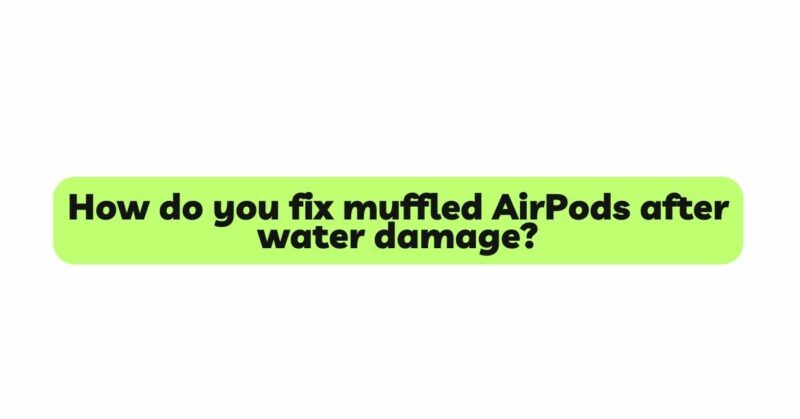Water damage can be a dreaded scenario for any electronic device, including Apple’s AirPods. Even with their water resistance capabilities, prolonged exposure to water or submersion can cause issues like muffled audio, reduced sound quality, or complete malfunction. If you find your AirPods producing muffled or distorted sound after encountering water, don’t panic. In this article, we will explore step-by-step methods to potentially restore your muffled AirPods after water damage, tips to avoid further damage, and when to seek professional help.
- Immediate Steps After Water Exposure:
Acting quickly after water exposure is crucial to prevent further damage. If your AirPods come into contact with water, follow these immediate steps:
a. Remove from water: Retrieve the AirPods from water or any wet surface promptly.
b. Turn off: Power off your AirPods immediately to prevent any short circuits or electrical issues.
c. Dry gently: Use a soft, clean cloth to carefully wipe off any visible water on the surface of the AirPods and the charging case.
d. Avoid heat sources: Refrain from using a hairdryer or any other heat source to dry the earbuds, as excessive heat can damage internal components.
- Air-Drying Method:
The air-drying method is a common technique used to deal with water-damaged AirPods. Follow these steps to maximize the chances of successful drying:
a. Open the case: Leave the AirPods and the charging case open and expose them to a dry, well-ventilated area.
b. Be patient: Allow at least 24 to 48 hours for the earbuds and case to dry thoroughly. Avoid using them during this period.
c. Reassemble and test: Once dried, reassemble the AirPods and check if they function properly before using them again.
- Checking for Water Residue:
After the air-drying process, carefully inspect the AirPods and charging case for any visible water residue. Use a magnifying glass or bright light to look for moisture in the charging ports, speaker grills, or the proximity sensors. If you spot any residue, use a cotton swab or compressed air to gently remove it.
- Checking Sound Quality:
Once you have completed the air-drying and residue removal process, it’s time to check the sound quality of your AirPods. Connect them to your device and play different types of audio, such as music, podcasts, or videos. Listen carefully to detect any signs of muffled or distorted sound.
- Resetting Your AirPods:
If you still experience muffled audio after the air-drying process, consider resetting your AirPods. Here’s how:
a. Place your AirPods in their charging case and close the lid.
b. Keep the lid closed for at least 30 seconds.
c. Open the lid, and the status light should flash white, indicating your AirPods have reset.
d. Reconnect your AirPods to your device and test the sound quality again.
- Cleaning the Speaker Grills:
Muffled audio can sometimes be caused by debris or water residue clogging the speaker grills. To clean them:
a. Use a soft-bristled brush or an unused toothbrush to gently remove any dirt or debris from the speaker grills.
b. Avoid using sharp objects that could damage the delicate components.
- Sucking Method:
Some users have reported success with the “sucking” method to potentially remove water or moisture from the speaker grills. Here’s how:
a. Place the muffled AirPod close to your mouth.
b. Create a tight seal around the speaker grill with your lips.
c. Suck gently for a few seconds, as if you were sipping through a straw.
d. Repeat the process for both AirPods.
Please note that this method is not a guaranteed fix and may not work for all cases of muffled audio.
- Ensuring Proper Fit and Position:
Improper fit or positioning of the AirPods in your ears can also cause muffled sound. Make sure the AirPods are seated correctly in your ears and that the speaker grills are unobstructed.
- Software Updates:
Ensure that your AirPods and connected devices are running the latest software updates. Sometimes, issues with sound quality can be resolved with software improvements.
- When to Seek Professional Help:
If the above methods fail to fix the muffled sound issue, it may be time to seek professional help. Contact Apple Support or visit an authorized service provider to have your AirPods inspected and repaired by trained technicians. Attempting DIY repairs beyond the methods mentioned above can void any remaining warranty or service options from Apple.
Conclusion:
Water damage can lead to muffled audio or other sound quality issues in your AirPods. If your AirPods encounter water exposure, act quickly, and follow the air-drying method to prevent further damage. After drying, inspect for water residue, reset your AirPods, clean the speaker grills, and check the sound quality. If the problem persists, consider seeking professional assistance from Apple or an authorized service provider. Remember, prevention is key, so take preventive measures to protect your AirPods from water-related issues and enjoy uninterrupted audio experiences with these revolutionary wireless earbuds.


